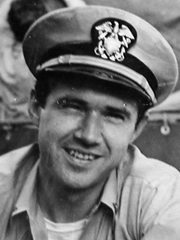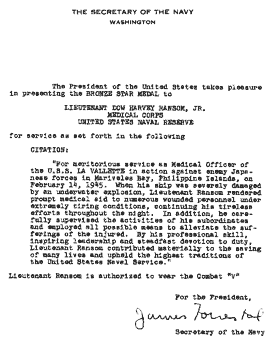Introduction to Doc Ransom’s Diary
By Jack Bell
In 1989, when I first became aware that there was a
La Vallette Association that had been in existence since 1981, I made inquiries if anyone had ever obtained a copy of the ship’s log or any other written record of the ship during the WWII years. I was sent a copy of
“Doc” Ransom’s diary, that Doc had kept and held exclusively for the benefit of his family. It was then that he made it available to some of the crew members who had it typed up and duplicated.
“Doc” Ransom was a giant amongst men. He had the respect of the entire crew long before we hit the mine, when he really showed his stuff. He would frequently get on the ship’s loudspeaker with some cute little ditty that he had made up about some member of the crew. — Jack Bell
In my opinion, it is a remarkable historical document, primarily because of the strict wartime restrictions that existed at that time against keeping diaries aboard a ship overseas. When I asked Doc how he happened to keep such a diary, he answered that his father, who was a very inquisitive man, had also been a physician in the US forces during WWI and would be asking all about his overseas experiences when he returned. He thought the best thing would be to write it down as it happened. By his doing that, there exists a two-year day-to-day record of the La Vallette.
Doc said that the first person outside of his immediate family to see the diary was J.W. Perkins, who was one of the former ship’s officers. In later years, J.W. Perkins was in a high-level government office in Washington, DC. During one of Perkins’ visits from DC, they were in a discussion and disagreeing about a date when some event had taken place. Doc said that it was easy to settle the matter, so he pulled out his diary. Apparently Perkins was astonished and uttered the comment, “Where in the world did this come from?”
When I inquired of Doc how old he was when aboard our ship as surgeon, he answered twenty-five or twenty-six. Further inquiries revealed that he had entered Stanford pre-med school at the age of sixteen and had been admitted into the accelerated medical program. He served his internship and residency at Oak Knoll Naval Hospital in Oakland, California, before coming aboard our ship as a surgeon. Years later, after the war, he changed his practice to the role of a family physician, the same as his father had been. He was still practicing at the age of seventy-three, up until six months before he died from cancer of the pancreas.
In the years after WWII, Doc Ransom was well known and respected in the medical field. He lived his entire life in the San Jose, California area.

